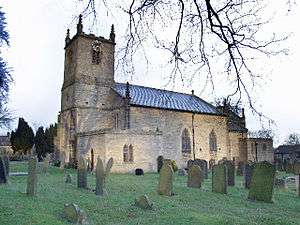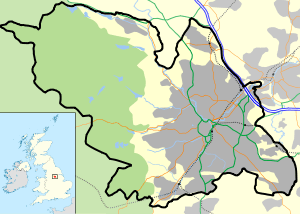Dore
Coordinates: 53°19′37″N 1°32′04″W / 53.32681°N 1.53453°W
Dore is a large village in South Yorkshire, England. The village lies on a hill above the River Sheaf which gave Sheffield its name, and until 1934 was part of Derbyshire, but it is now a suburb of the city. Dore is served by Dore and Totley railway station on the Hope Valley Line between Sheffield and Manchester. The railway tunnel between Dore and Totley under a limb of the Pennines to Hathersage in Derbyshire is the longest such in England, second only to the Severn Tunnel between England and South Wales. They are the longest main line railway tunnels anywhere in Great Britain - the London Underground and Channel Tunnel to France excepted, of course. Dore has long enjoyed a reputation of being Sheffield's wealthiest suburb, and Dore and Totley was the only ward of the city which regularly elected a Conservative councillor. However, as of May 2008 all three councillors were Liberal Democrats. The Member of Parliament for Sheffield Hallam constituency, of which Dore is part, is Liberal Democrat Nick Clegg, who from 2010 until 2015 served as Britain's deputy prime minister in the Coalition government.
History

The name Dore derives from the same Old English root as door, signifying a 'gateway' or pass between two kingdoms.[2] The Limb Brook, River Sheaf, and Meers Brook marked the boundary between the Anglo-Saxon kingdoms of Deira (later Northumbria) and Mercia.[3]
The Anglo-Saxon Chronicle contains the earliest written record of Dore, recording that in 827 (more likely 829) King Egbert of Wessex led his army to the village to receive the submission of King Eanred of Northumbria, thereby establishing his overlordship over the whole of Anglo-Saxon Britain:
- This year was the moon eclipsed, on mid-winter's mass-night; and King Egbert, in the course of the same year, conquered the Mercian kingdom, and all that is south of the Humber, being the eighth king who was sovereign of all the British dominions. Ella, king of the South-Saxons, was the first who possessed so large a territory; the second was Ceawlin, king of the West-Saxons: the third was Ethelbert, King of Kent; the fourth was Redwald, king of the East-Angles; the fifth was Edwin, king of the Northumbrians; the sixth was Oswald, who succeeded him; the seventh was Oswy, the brother of Oswald; the eighth was Egbert, king of the West-Saxons. This same Egbert led an army against the Northumbrians as far as Dore, where they met him, and offered terms of obedience and subjection, on the acceptance of which they returned home.[4]
It can therefore be reasonably argued that Egbert became the first king of all England at Dore. A plaque commemorating the event was erected on the village green in 1968 by the Dore Village Society. The Old School was built in 1821 on the site of a previous school, on the right hand side was the teacher's accommodation. When Dore's new school was opened, the Old School was restored and opened as a community centre.

Christ Church Dore was built in 1829 and Dore became a separate parish in 1844.[5] Dore remained a small village, having a population of just 500 in the 19th century, until it was annexed by Sheffield in 1933.[6]
A paper mill was built on Avenue Farm in the 17th century, Joshua Tyzack converted the building into a scythe forge in 1839 and in 1881 built a large house next to the forge as a country retreat, his initials can be seen above the front door. In 1932 Dore's Parish council built a memorial commemorating the deaths of the First World War.
Brinkburn Grange
Brinkburn Grange was built in 1883 by Thomas B. Matthews. The land was part of Bradway Mill and Matthews was director of Turton Brothers & Matthews, a Sheffield steel, file and spring makers. The mill dam was then used as an ornamental lake. The Grange was demolished in 1938.
Schools
Schools in Dore include Dore Primary School, King Ecgbert School (secondary) and the Rowan Primary Special School.
Residents
Notable residents include Gary Megson, a former footballer and manager of Sheffield Wednesday F.C., Dave Bassett, former footballer and former manager of Southampton F.C., Watford F.C., Sheffield United and Nottingham Forest F.C., and Chris Waddle, former England International and player with Sheffield Wednesday football club.
Former Sheffield United manager (and Manchester United player) Bryan Robson owns a penthouse in the village of Dore.
Former England footballer and Captain, the late Emlyn Hughes, lived in the village.
Michael Dent, the only British player to have ever won the European Table Soccer (Sports table football) Championship, first learnt to play Subbuteo whilst a teenager living in Dore.
Michael Vaughan of Yorkshire County Cricket Club and former captain of the England cricket team, is a resident;
Joe Root also of Yorkshire and now England's rising cricket star, currently vice-captain of England, was born and raised in Dore.
Abbeydale Park, a former county cricket ground for both Derbyshire and Yorkshire, lies just north of the suburb. Recently, Sheffield's Olympic gold medalist Jessica Ennis-Hill purchased a property in the village.
References
- ↑ Dore is made up of 18 output areas http://www.ukcensusdata.com/dore-and-totley-e05001048#sthash.PWwd7J2U.2Q6JUxf6.dpbs
- ↑ Vickers, J. Edward MBE (1999). Dore. In Old Sheffield Town. An Historical Miscellany (2nd ed.), pp64–71. Sheffield: The Hallamshire Press Limited. ISBN 1-874718-44-X
- ↑ Addy, Sidney Oldall (1888). "The Geographical or Ethnological Position of Sheffield". A Glossary of Words Used in the Neighbourhood of Sheffield. Including a Selection of Local Names, and Some Notices of Folk-Lore, Games, and Customs. London: Trubner & Co. for the English Dialect Society.
- ↑ Extract from the Anglo-Saxon Chronicle. Translations available at Berkeley Digital Library and Project Gutenberg
- ↑ "Dore History". Open Dore, a website of the Dore Village Society. Retrieved 29 May 2005.
- ↑ Harston, Jonathan G. (2005). "The borders of Sheffield from 1843 to 1994". Retrieved 19 August 2007.
External links
| Wikimedia Commons has media related to Dore, South Yorkshire. |
- Dore in the Domesday Book
- Dore Primary School website
- King Ecgbert School website
- Rowan Primary Special School website
- Sources for the history of Dore Produced by Sheffield City Council's Libraries and Archives
